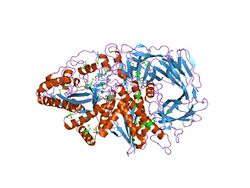Biology:Glycoside hydrolase family 38
| Glycosyl hydrolases family 38 N-terminal domain | |||||||||
|---|---|---|---|---|---|---|---|---|---|
 golgi alpha-mannosidase ii | |||||||||
| Identifiers | |||||||||
| Symbol | Glyco_hydro_38 | ||||||||
| Pfam | PF01074 | ||||||||
| Pfam clan | CL0158 | ||||||||
| InterPro | IPR000602 | ||||||||
| SCOP2 | 1o7d / SCOPe / SUPFAM | ||||||||
| CAZy | GH38 | ||||||||
| Membranome | 311 | ||||||||
| |||||||||
| Alpha mannosidase, middle domain | |||||||||
|---|---|---|---|---|---|---|---|---|---|
 golgi alpha-mannosidase ii | |||||||||
| Identifiers | |||||||||
| Symbol | Alpha-mann_mid | ||||||||
| Pfam | PF09261 | ||||||||
| InterPro | IPR015341 | ||||||||
| SCOP2 | 1o7d / SCOPe / SUPFAM | ||||||||
| |||||||||
| Glycosyl hydrolases family 38 C-terminal domain | |||||||||
|---|---|---|---|---|---|---|---|---|---|
 golgi alpha-mannosidase ii | |||||||||
| Identifiers | |||||||||
| Symbol | Glyco_hydro_38C | ||||||||
| Pfam | PF07748 | ||||||||
| Pfam clan | CL0103 | ||||||||
| InterPro | IPR011682 | ||||||||
| SCOP2 | 1o7d / SCOPe / SUPFAM | ||||||||
| CAZy | GH38 | ||||||||
| |||||||||
In molecular biology, glycoside hydrolase family 38 is a family of glycoside hydrolases.
Glycoside hydrolases EC 3.2.1. are a widespread group of enzymes that hydrolyse the glycosidic bond between two or more carbohydrates, or between a carbohydrate and a non-carbohydrate moiety. A classification system for glycoside hydrolases, based on sequence similarity, has led to the definition of >100 different families.[1][2][3] This classification is available on the CAZy web site,[4][5] and also discussed at CAZypedia, an online encyclopedia of carbohydrate active enzymes.[6][7]
Glycoside hydrolase family 38 CAZY GH_38 comprises enzymes with only one known activity; alpha-mannosidase (EC 3.2.1.24) (EC 3.2.1.114).
Lysosomal alpha-mannosidase is necessary for the catabolism of N-linked carbohydrates released during glycoprotein turnover. The enzyme catalyzes the hydrolysis of terminal, non-reducing alpha-D-mannose residues in alpha-D-mannosides, and can cleave all known types of alpha-mannosidic linkages. Defects in the gene cause lysosomal alpha-mannosidosis (AM), a lysosomal storage disease characterised by the accumulation of unbranched oligo-saccharide chains.
A domain, which is found in the central region adopts a structure consisting of three alpha helices, in an immunoglobulin/albumin-binding domain-like fold. The domain is predominantly found in the enzyme alpha-mannosidase.[8]
References
- ↑ "Conserved catalytic machinery and the prediction of a common fold for several families of glycosyl hydrolases". Proceedings of the National Academy of Sciences of the United States of America 92 (15): 7090–4. July 1995. doi:10.1073/pnas.92.15.7090. PMID 7624375. Bibcode: 1995PNAS...92.7090H.
- ↑ "Structures and mechanisms of glycosyl hydrolases". Structure 3 (9): 853–9. September 1995. doi:10.1016/S0969-2126(01)00220-9. PMID 8535779.
- ↑ "Updating the sequence-based classification of glycosyl hydrolases". The Biochemical Journal 316 (Pt 2): 695–6. June 1996. doi:10.1042/bj3160695. PMID 8687420.
- ↑ "Home" (in en). http://www.cazy.org/.
- ↑ "The carbohydrate-active enzymes database (CAZy) in 2013". Nucleic Acids Research 42 (Database issue): D490-5. January 2014. doi:10.1093/nar/gkt1178. PMID 24270786.
- ↑ "Glycoside Hydrolase Family 38" (in en). http://www.cazypedia.org/index.php/Glycoside_Hydrolase_Family_38.
- ↑ CAZypedia Consortium (December 2018). "Ten years of CAZypedia: a living encyclopedia of carbohydrate-active enzymes". Glycobiology 28 (1): 3–8. doi:10.1093/glycob/cwx089. PMID 29040563. http://eprints.whiterose.ac.uk/122863/1/CAZypedia_20171003_Figures.pdf.
- ↑ "The structure of bovine lysosomal alpha-mannosidase suggests a novel mechanism for low-pH activation". Journal of Molecular Biology 327 (3): 631–44. March 2003. doi:10.1016/S0022-2836(03)00172-4. PMID 12634058.
 |

